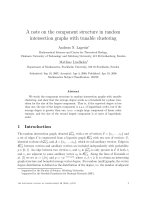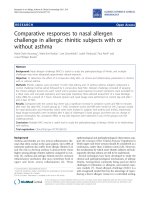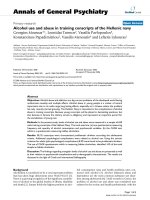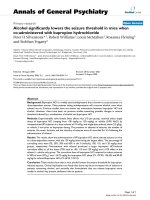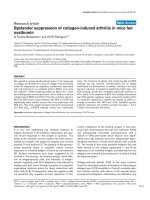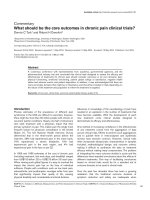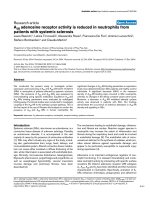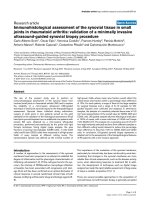Báo cáo y học: "Alcohol significantly lowers the seizure threshold in mice when co-administered with bupropion hydrochloride" ppsx
Bạn đang xem bản rút gọn của tài liệu. Xem và tải ngay bản đầy đủ của tài liệu tại đây (315.04 KB, 7 trang )
BioMed Central
Page 1 of 7
(page number not for citation purposes)
Annals of General Psychiatry
Open Access
Primary research
Alcohol significantly lowers the seizure threshold in mice when
co-administered with bupropion hydrochloride
Peter H Silverstone*
1
, Robert Williams
2
, Louis McMahon
2
, Rosanna Fleming
3
and Siobhan Fogarty
2
Address:
1
Clinical Affairs, Biovail Corporation, Mississauga, Ontario, Canada,
2
Research and Development, Biovail Technologies Ltd., Dublin,
Ireland and
3
Statistical Group, Biovail Technologies Ltd., Bridgewater, New Jersey, USA
Email: Peter H Silverstone* - ; Robert Williams - ; Louis McMahon - ;
Rosanna Fleming - ; Siobhan Fogarty -
* Corresponding author
Abstract
Background: Bupropion HCl is a widely used antidepressant that is known to cause seizures in a
dose-dependent manner. Many patients taking antidepressants will consume alcohol, even when
advised not to. Previous studies have not shown any interactions between bupropion HCl and
alcohol. However, there have been no previous studies examining possible changes in seizure
threshold induced by a combination of alcohol and bupropion HCl.
Methods: Experimentally naïve female Swiss albino mice (10 per group) received either single
doses of bupropion HCl (ranging from 100 mg/kg to 120 mg/kg) or vehicle (0.9% NaCl) by
intraperitoneal (IP) injection in a dose volume of 10 ml/kg, and single-dose ethanol alone (2.5 g/kg),
or vehicle, 5 min prior to bupropion dosing. The presence or absence of seizures, the number of
seizures, the onset, duration and the intensity of seizures were all recorded for 5 h following the
administration of ethanol.
Results: The results show that administration of IP bupropion HCl alone induced seizures in mice
in a dose-dependent manner, with the 120 mg/kg dose having the largest effect. The percentage of
convulsing mice were 0%, 20%, 30% and 60% in the 0 (vehicle), 100, 110, and 120 mg/kg dose
groups, respectively. Pretreatment with ethanol produced a larger bupropion HCl-induced
convulsive effect at all the doses (70% each at 100, 110 and 120 mg/kg) and a 10% effect in the
ethanol + vehicle only group. The convulsive dose of bupropion HCl required to induce seizures
in 50% of mice (CD
50
), was 116.72 mg/kg for bupropion HCl alone (CI: 107.95, 126.20) and 89.40
mg/kg for ethanol/bupropion HCl (CI: 64.92, 123.10).
Conclusion: These results show that in mice alcohol lowers the seizure threshold for bupropion-
induced seizures. Clinical implications are firstly that there may be an increased risk of seizures in
patients consuming alcohol, and secondly that formulations that can release bupropion more
readily in alcohol may present additional risks to patients.
Published: 18 August 2008
Annals of General Psychiatry 2008, 7:11 doi:10.1186/1744-859X-7-11
Received: 28 November 2006
Accepted: 18 August 2008
This article is available from: />© 2008 Silverstone et al; licensee BioMed Central Ltd.
This is an Open Access article distributed under the terms of the Creative Commons Attribution License ( />),
which permits unrestricted use, distribution, and reproduction in any medium, provided the original work is properly cited.
Annals of General Psychiatry 2008, 7:11 />Page 2 of 7
(page number not for citation purposes)
Introduction
Bupropion HCl is known to cause seizures both when
given at therapeutic doses or following accidental or
intentional overdose in a dose-dependent manner [1-7].
It is also known that factors which include the excessive
use of alcohol and sedatives, history of head trauma or
prior seizure, and substance abuse, to mention a few, are
associated with increased risk of bupropion-induced sei-
zures [7]. In addition, postmarketing surveillance reports
have indicated that there have been rare cases of adverse
neuropsychiatric events or reduced alcohol tolerance in
patients who are taking alcohol during treatment with
bupropion [7]. Despite these latter reports, previous stud-
ies of the pharmacokinetic and/or pharmacodynamic
interactions between alcohol and bupropion have
revealed no significant pharmacodynamic interactions in
animals [8], and no pharmacokinetic interactions in
healthy human volunteers [9]. Furthermore, there are no
studies specifically investigating the interaction between
alcohol and bupropion-induced seizures in animals or
man. Therefore, the objective of this study was to evaluate
the effect of ethanol pretreatment on single-dose bupro-
pion HCl-induced seizures in the Swiss albino mouse
model.
Materials and methods
The study protocol and any amendment(s) or procedures
involving the care and use of animals were reviewed and
approved by an appropriate ethics committee following
internationally approved guidelines (Charles River Labo-
ratories Preclinical Services Inc.'s (CRM) Institutional Ani-
mal Care and Use Committee; Charles River Laboratories,
Wilmington, MA, USA). During the study, the animals
were maintained in a facility fully accredited by the Stand-
ards Council of Canada (SCC) and the care and use of the
animals was conducted in accordance with the guidelines
of the Canadian Council on Animal Care (CCAC).
Animals
Experimentally naïve female Swiss Crl: CD1 (ICR) albino
mice (Mus Musculus; Charles River Canada Inc., St. Con-
stant, Quebec, Canada) of approximately 7 weeks of age,
and weighing 17.3 to 28.6 g were housed individually in
stainless steel wire mesh-bottomed cages equipped with
an automatic watering valve in an environmentally con-
trolled vivarium (temperature 22 ± 3°C; relative humidity
50 ± 20%) with a 12-h light/dark cycle. All animals were
acclimated to their cages and to the light/dark cycle for 3
days before the initiation of treatment. In addition, all
animals had free access ad libitum to a standard certified
pelleted commercial laboratory diet (PMI Certified
Rodent Diet 5002; PMI Nutrition International Inc., St
Louis, MO, USA) and tap water except during designated
procedures. Animals were randomly assigned to 8 treat-
ment groups of 10 mice per group, using a computer-gen-
erated randomisation scheme, ensuring stratification by
body weights. Four groups were pretreated with ethanol
followed by treatment with increasing doses of bupropion
HCl as follows: group 1, ethanol 2.5 g/kg + 0 mg/kg (vehi-
cle); group 2, ethanol 2.5 g/kg + 100 mg/kg; group 3, eth-
anol 2.5 g/kg + 110 mg/kg; and group 4, ethanol 2.5 g/kg
+ 120 mg/kg. The other four groups were only treated with
the same increasing doses of bupropion HCl as follows:
group 5, 0 mg/kg (vehicle only); group 6, 100 mg/kg;
group 7, 110 mg/kg; and group 8, 120 mg/kg. The doses
of bupropion HCl 100 to 120 mg/kg selected for this
study are higher than the low dose of 12.5 mg/kg used in
a previous study [8] because more recent studies have
revealed that bupropion HCl at low doses of 15 to 30 mg/
kg does not induce seizures but protects albino mice
against seizures induced by maximal electroshock (anti-
convulsant), and at high doses of 100 to 160 mg/kg is pro-
convulsant in the mice [10]. Animals in poor health or at
the extremes of the prespecified body weight range (18 to
30 g) were not assigned to treatment groups and unas-
signed animals were released from the study.
Drugs
Bupropion HCl was obtained from Biovail Corporation,
Steinbach, Manitoba, Canada, in white powder form. The
dose formulations of bupropion HCl were prepared on
each day. The appropriate amount of bupropion HCl was
weighed and dissolved in an appropriate amount of 0.9%
NaCl and then vortexed until a solution was obtained. On
each day of treatment, the single doses of bupropion HCl
dose were administered by intraperitoneal (IP) injection
in a dose volume of 10 ml/kg and dose concentrations of
0, 10, 11, and 12 mg/ml for the 0, 100, 110, and 120 mg/
kg doses. The actual dose administered was based on the
most recent body weight of each animal. In the applicable
treatment groups (groups 1 to 4), each animal was pre-
treated with ethanol in a dose volume of 10 ml/kg 5 min
prior to bupropion dosing. Ethanol was obtained in liq-
uid form from Les Alcools de Commerce Inc., Montreal,
Quebec, Canada. Ethanol 2.5 g/kg was administered as a
dose volume of 10 ml/kg, and a dose concentration of
0.25 g/ml. Vehicle was 0.9% sodium chloride (NaCl) for
injection USP and was obtained from Baxter Healthcare
Corporation, Deerfield, IL, USA.
Study procedure
All animals were examined twice daily for mortality and
signs of ill health or reaction to treatment, except on the
days of arrival and necropsy when they were examined
only once. After the acclimation period and randomisa-
tion, on the day prior to the initiation of treatment, all
animals were weighed and the individual body weights
were used for dose volume calculation. Treatment was
then initiated and lasted for 4 consecutive days with equal
numbers of animals from each group dosed on each day.
Annals of General Psychiatry 2008, 7:11 />Page 3 of 7
(page number not for citation purposes)
On the days of treatment, approximately 5 min prior to
bupropion HCl or vehicle dosing, animals in groups 1 to
4 were pretreated with a single dose of ethanol 2.5 g/kg IP
in a dose volume of 10 ml/kg. These animals then
received the assigned dose of bupropion HCl or vehicle
IP. Animals in groups 5 to 8 were not pretreated with eth-
anol but received their assigned dose of bupropion HCl or
vehicle by the IP route. Thereafter, the animals were
placed in clear perspex observation boxes containing a
foam base for padding and observed for the occurrence of
seizures for 5 h, followed by a 5 min assessment at 24 h
post dose. The presence or absence of seizures, the
number of seizures, the onset, duration and intensity of
seizures were all recorded. The intensity of each convul-
sion was graded using Charles River Laboratories, Inc.'s
grading system of mild: head and tail slightly extended
and little jerking; moderate: head and tail fully extended
and some jerking; or severe: head and tail fully extended
and strong jerking. In addition, the presence or absence of
ataxic gait, paralysis, and catatonic episodes (without a
grading of the intensity or number) were recorded over
each 15 min observation period. Any animal that had a
single episode of severe seizure lasting longer than 1 min
or any animal displaying greater than 40 separate epi-
sodes of severe seizures over a 1-h period was sacrificed for
humane reasons. At the end of the 5-h observation period,
all animals were returned to their home cages, and as
deemed necessary, additional bedding, food (on cage
floor) and water bottles were provided if an animal was
still showing adverse effects from the administration of
study drugs.
Assessment of convulsant activity
The primary outcome variable was the percentage of mice
that had seizures. This was the number of animals with
seizures (mild, moderate or severe) divided by the total
number of animals in each group multiplied by 100. In
addition, the convulsive dose of bupropion HCl required
to induce seizures in 50% of mice (CD
50
), was calculated
for the dose-response curves for bupropion HCl treatment
alone and the ethanol/bupropion HCl treatment. The sec-
ondary outcome variables were the mean (SD) seizures
per mouse in each group, and the duration of seizures.
Data presentation and statistical analysis
Data was summarised and presented in tables by treat-
ment groups for the primary outcome variable, the per-
centage of convulsing mice, and the two secondary
outcome variables, the mean (SD) seizures per mouse in
each group, and the duration of seizures. The CD
50
values
were calculated using the PROBIT procedure in SAS (SAS
Inc., Cary, NC, USA). The 95% confidence limits for CD
50
were calculated according to the method of Litchfield and
Wilcoxon [11]. A total of 10 mice per group (total of 40
animals) were used to calculate the CD
50
for the bupro-
pion alone treatments, and 39 animals for the CD
50
for
the ethanol/bupropion HCl treatments. The number of
seizures per mouse was analysed using analysis of vari-
ance (ANOVA) on the rank-transformed values, with pres-
ence of ethanol (yes/no), bupropion dose, and presence
of ethanol-by-bupropion dose interaction as fixed effects
in the model. p Values of ≤ 0.05 were considered statisti-
cally significant.
Results
In all groups, except the group treated with vehicle only
(group 5), a convulsive effect was observed following the
administration of bupropion HCl and/or ethanol. The
onset of convulsion was about 9 min following the
administration of single doses of bupropion HCl, how-
ever, this was highly variable between animals in the same
group and across the dose levels for the bupropion HCl
alone and ethanol/bupropion HCl treatments. The inten-
sity of the seizures observed following bupropion HCl
alone treatment were only mild and moderate (Table 1).
Following ethanol pretreatment, overall, there was an
increase in the intensity of the bupropion HCl-induced
seizures at all the doses. In the 100 mg/kg dose group
(group 5), there were marked increases in the number of
mild, moderate and severe seizures. In the 110 and 120
Table 1: Effect of ethanol pretreatment on bupropion HCI-induced convulsions: intensity of convulsions
Dose (mg/kg), n =
10 per group
Intensity of convulsions
Mild Moderate Severe
BUP ET + BUP BUP ET + BUP BUP ET + BUP
0 (V or ET +V) 010100
100 1 37 1 65 0 7
110 21 10 1 5 0 0
120 19 17 2 4 0 0
n = 10 mice per group for bupropion HCl alone and ethanol + bupropion HCl treatment groups.
BUP, bupropion HCl; ET, ethanol; V, vehicle or 0.9% sodium chloride (NaCl).
Annals of General Psychiatry 2008, 7:11 />Page 4 of 7
(page number not for citation purposes)
mg/kg dose groups, there was a redistribution of the
intensity of the seizures resulting in reductions in the mild
seizures but a fivefold and twofold increase, respectively,
in the moderate seizures (Table 1).
There were no deaths in the study. One animal treated
with ethanol/bupropion HCl 110 mg/kg had excessive
convulsions and was therefore euthanised for humane
reasons. A variety of clinical signs were observed in the
mice following the administration of bupropion HCl,
some of which include paralysis, ataxic gait, catatonia,
increased respiratory rate, twitching, tremors, increased
activity, decreased activity, partially closed eyes, etc. Clin-
ical signs were not dose dependent and pretreatment with
ethanol had no effect on the signs observed.
Percentage of convulsing mice
Administration of single doses of IP bupropion HCl alone
induced seizures in mice in a dose-dependent manner
with the 120 mg/kg dose showing the largest effect. The
percentage of convulsing mice were 0%, 20%, 30% and
60% in the 0 (vehicle only = 0.9% NaCl), 100, 110, and
120 mg/kg dose groups, respectively (Table 2 and Figure
1). Pretreatment with ethanol produced a larger bupro-
pion HCl-induced convulsive effect at all the doses
including the ethanol + vehicle only group. There was a
marked increase in the percentage of convulsing mice
(70% of convulsing mice) at the ethanol/bupropion HCl
100 mg/kg dose, compared to bupropion HCl alone treat-
ment, which was maintained at the ethanol/bupropion
HCl 110 and 120 mg/kg doses, resulting in a flat dose-
response curve (Table 2 and Figure 1). Ethanol/vehicle
(group 1) treatment induced a 10% incidence of seizures.
The CD
50
or convulsive dose
50
, the convulsive doses of
bupropion HCl required to induce seizures in 50% of
mice, were 116.72 (CI: 107.95, 126.20) and 89.40 (CI:
64.92, 123.10) mg/kg for the dose-response curves for
bupropion alone and ethanol/bupropion HCl treatments,
respectively (Figure 1). The CD
50
of 116.72 (CI: 107.95,
126.20) mg/kg for bupropion HCl alone treatment is sim-
ilar to the value of 119.7 (CI: 104.1, 137.6) mg/kg
reported previously for IP bupropion HCl in Swiss mice
[10].
Mean convulsions per mouse
The analysis of variance results showed a significant over-
all effect of ethanol pretreatment and bupropion dose on
the number of bupropion HCl-induced seizures, and a
borderline significant overall ethanol-bupropion interac-
tion effect at the p ≤ 0.10 level (Table 3). Single-dose
bupropion HCl alone treatment induced a dose-depend-
ent increase in the mean (SD) seizures per mouse from 0
in the vehicle only-treated group (bupropion HCl 0 mg/
kg) to 2.20 (4.49) seizures per mouse in the 110 mg/kg
dose group, which was maintained at the 120 mg/kg dose
group (mean (SD) convulsions per mouse = 2.10 (1.97)).
Pretreatment with ethanol markedly and significantly
increased the mean (SD) seizures per mouse compared to
bupropion HCl alone treatment only in the 100 mg/kg
dose group (ethanol/bupropion HCl = 10.90 (17.28);
bupropion HCl alone = 0.20 (0.42); p = 0.0019). There
were no statistically significant differences between the
mean (SD) seizures per mouse obtained for ethanol/
bupropion HCl versus bupropion alone treatments for the
0, 110 and 120 mg/kg dose groups (Table 3).
Duration of convulsions
Administration of single doses of bupropion HCl alone
induced only short and medium duration seizures. The
number of short seizures increased with dose to a maxi-
mum of 22 at the 110 mg/kg dose with a slight decrease
to 18 at the 120 mg/kg dose (Table 4). In contrast, pre-
treatment with ethanol increased the total numbers of
bupropion HCl-induced short and medium seizures, as
well as caused long seizures. In addition, the number of
short, medium and long seizures was markedly highest at
Dose-response curves of the percentage of convulsing mice following the administration of bupropion HCl alone (closed circles) and the effect of ethanol pretreatment on bupropion HCl-induced seizures (open circles) in the Swiss albino miceFigure 1
Dose-response curves of the percentage of convuls-
ing mice following the administration of bupropion
HCl alone (closed circles) and the effect of ethanol
pretreatment on bupropion HCl-induced seizures
(open circles) in the Swiss albino mice. The 50% con-
vulsing dose (CD
50
) values, the convulsant doses of bupro-
pion HCl required to induce seizures in 50% of mice were
116.72 (CI: 107.95, 126.20) and 89.40 (CI: 64.92, 123.10) mg/
kg for the dose-response curves for bupropion alone and ET
+ bupropion HCl, respectively. Doses of bupropion HCl
administered intraperitoneally (IP) were 0 (vehicle or ET +
vehicle only), 100, 110, and 120 mg/kg. Ethanol pretreatment
was with 2.5 g/kg IP 5 min prior to administration of bupro-
pion HCl. Each data point is the percentage of convulsing
mice in n = 10 mice. ET, ethanol + vehicle; S, vehicle (0.9%
NaCl).
Annals of General Psychiatry 2008, 7:11 />Page 5 of 7
(page number not for citation purposes)
the 100 mg/kg dose followed by a marked reduction at the
110 mg/kg dose and a further reduction at the 120 mg/kg
dose only for the medium and long seizures (Table 4).
Discussion
The pharmacokinetic and pharmacodynamic interactions
of ethanol with antidepressant drugs are well known [12-
17]. Interactions between ethanol and psychotropic drugs
could be additive, synergistic (potentiation) or antagonis-
tic [15]. Even though there are published reports of ani-
mal [8] and human [9,18] studies investigating the
pharmacokinetic and/or pharmacodynamic interactions
between alcohol and bupropion, there are no published
studies precisely evaluating the effects of alcohol on the
convulsive liability of bupropion. This study was therefore
designed to investigate the effect of ethanol pretreatment
on single-dose bupropion HCl-induced seizures in the
Swiss albino mice. The results of the primary outcome var-
iable showed that bupropion HCl alone treatment in the
dosage range 0 to 120 mg/kg was associated with a dose-
dependent increase in the percentage of mice with bupro-
pion HCl-induced seizures. This finding is consistent with
previous reports that indicate bupropion induces seizures
in a dose-dependent manner in animals [10,19] and
humans [2,3,7]. Pretreatment with ethanol resulted in
markedly increased percentage of mice with bupropion
HCl-induced seizures at the 100 mg/kg dose, which was
maintained at the 110 and 120 mg/kg doses. The latter
results are consistent with a 3.5-, 2.3- and 1.2-fold
increase in the percentage of convulsing mice at the 100,
110 and 120 mg/kg doses, respectively, following ethanol
pretreatment. In addition, ethanol pretreatment resulted
in a flat dose-response within the dosage range of 100 to
120 mg/kg studied. The CD
50
for bupropion HCl alone
treatment, a well known index of convulsive liability, of
116.72 (CI: 107.95, 126.20) mg/kg is similar to the value
of 119.7 (CI: 104.1, 137.6) mg/kg reported previously for
bupropion HCl in Swiss mice [10], and confirms the
validity of this animal model. Pretreatment with ethanol
resulted in a 23% reduction in the CD
50
value for bupro-
pion HCl-induced seizures.
The results of the secondary outcome variables were gen-
erally consistent with the results of the primary outcome
variable. Bupropion HCl alone treatment induced a dose-
dependent increase in the mean seizures per mouse up to
the 110 mg/kg dose, which was maintained at the 120
mg/kg dose. Ethanol pretreatment resulted in a marked
and statistically significant 54-fold increase in bupropion
HCl-induced mean seizures per mouse only at the 100
Table 2: Effect of ethanol pretreatment on bupropion HCI-induced convulsions: percentage of convulsing mice
Dose (mg/kg), n = 10
per group
No. of convulsing mice Percentage of convulsing mice
Bupropion
HCl
ET + Bupropion
HCl
Bupropion
HCl
ET + Bupropion
HCl
0 (vehicle or
ET+vehicle)
01 0%10%
100 2 7 20% 70%
110 3 7 30% 70%
120 6 7 60% 70%
n = 10 mice per group for bupropion HCl alone and ethanol + bupropion HCl treatment groups.
ET, ethanol; vehicle, 0.9% sodium chloride (NaCl).
Table 3: Effect of ethanol pretreatment on bupropion HCI-induced convulsions: mean standard deviation (SD) convulsions per mouse
Dose (mg/kg), n =
10 per group
Total no. of convulsions Mean (SD) convulsions per mouse
BUP ET + BUP BUP ET + BUP p Value
0 (V or ET +V) 0 2 0.00 (0.00) 0.20 (0.63) 0.1027*
100 2 109 0.20 (0.42) 10.90 (7.28)†
110 22 15 2.20 (4.49) 1.50 (1.72)
120 21 21 2.10 (1.97) 2.10 (3.35)
n = 10 mice per group for bupropion HCl alone and ethanol + bupropion HCl treatment groups.
*p Value for overall ethanol-bupropion interaction effect (ethanol effect, overall p = 0.0183; bupropion dose effect, overall p = 0.0007).
†p = 0.0019 for pairwise comparison with corresponding mean value for bupropion alone treatment.
BUP, bupropion HCl; ET, ethanol; SD, standard deviation; V, vehicle or 0.9% sodium chloride (NaCl).
Annals of General Psychiatry 2008, 7:11 />Page 6 of 7
(page number not for citation purposes)
mg/kg dose. There were no significant differences in
bupropion HCl-induced mean seizures per mouse at the
110 and 120 mg/kg doses following ethanol pretreat-
ment. With respect to the duration of seizures, bupropion
HCl alone treatment only induced short and medium
duration seizures, which when combined was dose
dependent up to the 110 mg/kg dose. Ethanol pretreat-
ment increased the duration of the seizures overall, result-
ing in more episodes of short, medium, and long duration
bupropion HCl-induced seizures, but particularly in the
100 mg/kg dose group.
The results of this study are in conflict with the results of
previous studies that reported no pharmacodynamic
interactions between alcohol and bupropion in mice [8],
and no pharmacokinetic interactions in normal healthy
volunteers [9]. The reason for the discrepant previous
results may be because those studies of the pharmacoki-
netic and pharmacodynamic interactions between alco-
hol and bupropion in normal healthy volunteers [9,18]
used a low dose of bupropion (100 mg, approximately 1.5
mg/kg) that is unlikely to be associated with the occur-
rence of seizures since bupropion-induced seizures are
dose dependent. Similarly, a previous study [8] investigat-
ing the interactive effect of combined treatment with alco-
hol and bupropion in adult albino mice utilised a low
dose of bupropion (12.5 mg/kg IP) which is much lower
than the convulsive doses of 100 to 160 mg/kg IP, with a
CD
50
of 119.7 (CI: 104.1, 137.6) mg/kg and CD
97
of
156.7 mg/kg, that were subsequently reported for bupro-
pion in mice by other investigators [10]. In addition,
lower doses of bupropion (15 to 30 and 5 to 10 mg/kg,
respectively), which did not induce seizures, have been
reported to protect against seizures evoked by maximal
electroshock [10] and nicotine [20] in mice. However,
one group has reported that the combination of bupro-
pion with alcohol abolished the impairment in auditory
vigilance and mental slowness observed following the
administration of alcohol alone in normal healthy volun-
teers (a pharmacodynamic interaction) even though they
used a low dose of bupropion (100 mg) and found no
pharmacokinetic interaction [18].
The mechanism of bupropion HCl-induced seizures is
unknown [21,22]. Similarly, the mechanism for the syn-
ergistic interaction reported here between ethanol and
bupropion HCl is also unknown. This interaction is
unlikely to be solely due to pharmacokinetic reasons since
a previous crossover study that investigated the interac-
tions between alcohol and bupropion found no such
interactions [9]. This previous study, also in normal
healthy human volunteers, examined the effect of admin-
istration of oral bupropion HCl 100 mg followed by the
administration of ethanol found no changes in the phar-
macokinetics of bupropion, and vice versa [9].
The observed interaction between ethanol and bupropion
reported in the present study has potential clinical impli-
cations. It has been recognised that the seizure risk of
bupropion is increased in subjects undergoing abrupt
withdrawal from alcohol [3,4], hence, bupropion admin-
istration is contraindicated in such patients [7]. However,
the more recent although rare postmarketing reports of
adverse neuropsychiatric events or reduced alcohol toler-
ance in patients who are drinking alcohol during treat-
ment with bupropion [7], suggests that there is an
interaction between alcohol and bupropion following
coadministration, consistent with the findings of this
study. Consequently, patients should be cautioned to not
consume alcohol with bupropion. Nonetheless, there is
good evidence that many patients on bupropion, as well
as other anti-depressants, continue to use alcohol [23].
In conclusion, the results of this study demonstrate that
ethanol pretreatment followed by single-dose IP bupro-
pion HCl resulted in an increase in the number and per-
Table 4: Effect of ethanol pretreatment on bupropion HCI-induced convulsions: duration of convulsions
Dose (mg/kg),
n = 10 per
group
Duration of convulsions
No. of short convulsions
(0 to 10 s)
No. of medium
convulsions
(11 to 30 s)
No. of long convulsions
(≥ 31 s)
BUP ET + BUP BUP ET + BUP BUP ET + BUP
0 (V or ET +V) 0 1 0 1 0 0
100 1 78 1 17 0 14
110 22 6 0 3 0 6
120 18 17 3 1 0 3
n = 10 mice per group for bupropion HCl alone and ethanol + bupropion HCl treatment groups.
BUP, bupropion HCl; ET, ethanol; V, vehicle or 0.9% sodium chloride (NaCl).
Publish with BioMed Central and every
scientist can read your work free of charge
"BioMed Central will be the most significant development for
disseminating the results of biomedical research in our lifetime."
Sir Paul Nurse, Cancer Research UK
Your research papers will be:
available free of charge to the entire biomedical community
peer reviewed and published immediately upon acceptance
cited in PubMed and archived on PubMed Central
yours — you keep the copyright
Submit your manuscript here:
/>BioMedcentral
Annals of General Psychiatry 2008, 7:11 />Page 7 of 7
(page number not for citation purposes)
centage of convulsing mice, mean seizures per mouse, the
intensity, and the duration of the seizures. Following eth-
anol pretreatment, the CD
50
for bupropion HCl alone
treatment was reduced from 116.7 to 89.0 mg/kg, repre-
senting a 23% reduction. The dose-related increase in the
percentage of convulsing mice and mean seizures per
mouse is consistent with previous reports that bupropion-
induced seizures are dose dependent in animals and
humans. The observed pharmacodynamic interaction
between ethanol and bupropion-induced seizures in this
study is novel and the mechanism is unknown. However,
it has potential clinical implications for the prescribing of
bupropion. It also implies that caution should be used
when bupropion is prescribed to patients either using
alcohol or at high risk of doing so.
Competing interests
The authors declare that they have no competing interests.
Authors' contributions
The study was conceived by PHS and RW, was designed by
LM and SF who were also involved in data acquisition, the
first draft of the paper was by PHS, it was carried out in
part by LM, and the statistical analysis was by RF. Funding
for the conduct of this study and the manuscript prepara-
tion was provided by Biovail Laboratories International
SRL.
References
1. Peck AW, Stern WC, Watkinson C: Incidence of seizures during
treatment with tricyclic antidepressant drugs and bupro-
pion. J Clin Psychiatry 1983, 44:197-201.
2. Van Wyck Fleet J, Manberg PJ, Miller LL, Harto-Truax N, Sato T, Fleck
RJ, Stern WC, Cato AE: Overview of clinically significant
adverse reactions to bupropion. J Clin Psychiatry 1983,
44:191-196.
3. Davidson J: Seizures and bupropion: a review. J Clin Psychiatry
1989, 50:256-261.
4. Johnston JA, Lineberry CG, Ascher JA, Davidson J, Khayrallah MA,
Feighner JP, Stark P: A 102-center prospective study of seizure
in association with bupropion. J Clin Psychiatry 1991, 52:450-456.
5. Balit CR, Lynch CN, Isbister GK: Bupropion poisoning: a case
series. Med J Aust 2003, 178:61-63.
6. Shepherd G, Velez LI, Keyes DC: Intentional bupropion over-
doses. J Emerg Med 2004, 27:147-151.
7. GlaxoSmithKline: Wellbutrin XL (bupropion hydrochloride extended-
release tablets), product monograph Brentford, Middlesex, UK: Glaxo-
SmithKline; 2003.
8. Tartara A, Formigli L, Crema F, Maurelli M, Perucca E, Marchioni E,
Manzo L, Savoldi F: Alcohol interactions with typical and atypi-
cal antidepressants. Neurobehav Toxicol Teratol 1985, 7:139-141.
9. Posner J, Bye A, Jeal S, Peck AW, Whiteman P: Alcohol and bupro-
pion pharmacokinetics in healthy male volunteers. Eur J Clin
Pharmacol 1984, 26:627-630.
10. Tutka P, Barczynski B, Wielosz M: Convulsant and anticonvulsant
effects of bupropion in mice. Eur J Pharmacol 2004, 499:117-120.
11. Litchfield JT Jr, Wilcoxon F: A simplified method of evaluating
dose-effect experiments. J Pharmacol Exp Ther 1949, 96:99-113.
12. Seppala T, Linnoila M, Elonen E, Mattila MJ, Maki M: Effect of tricy-
clic antidepressants and alcohol in psychomotor skills
related to driving. Clin Pharmacol Ther
1975, 17:515-522.
13. Cott JM, Ogren SO: Antidepressant drugs and ethanol: behav-
ioral and pharmacokinetic interactions in mice. J Neural
Transm 1980, 48:223-240.
14. Dorian P, Sellers EM, Reed KL, Warsh JJ, Hamilton C, Kaplan HL, Fan
T: Amitriptyline and ethanol: pharmacokinetic and pharma-
codynamic interaction. Eur J Clin Pharmacol 1983, 25:325-331.
15. Weller RA, Preskorn SH: Psychotropic drugs and alcohol: phar-
macokinetic and pharmacodynamic interactions. Psychoso-
matics 1984, 25:301-309.
16. Shoaf SE, Linnoila M: Interaction of ethanol and smoking on the
pharmacokinetics and pharmacodynamics of psychotropic
medications. Psychopharmacol Bull 1991, 27:577-594.
17. Fraser AG: Pharmacokinetic interactions between alcohol
and other drugs. Clin Pharmacokinet 1997, 33:79-90.
18. Hamilton MJ, Bush MS, Peck AW: The effect of bupropion, a new
antidepressant drug, and alcohol and their interaction in
man. Eur J Clin Pharmacol 1984, 27:75-80.
19. Tutka P, Mroz T, Klucha K, Piekarczyk M, Wielosz M: Bupropion-
induced seizures: preclinical evaluation of antiepileptic
drugs. Epilepsy Res 2005, 64:13-22.
20. Slemmer JE, Martin BR, Damaj MI: Bupropion is a nicotinic antag-
onist. J Pharmacol Exp Ther 2000, 295:321-327.
21. Preskorn SH: Bupropion: what mechanism of action? J Pract Psy-
chiatry Behav Health 2000:272-276.
22. Ascher JA, Cole JO, Colin JN, Feighner JP, Ferris RM, Fibiger HC,
Golden RN, Martin P, Potter WZ, Richelson E, Sulser F: Bupropion:
a review of its mechanism of antidepressant activity. J Clin Psy-
chiatry 1995, 56:395-401.
23. Brown RL, Dimond AR, Hulisz D, Saunders LA, Bobula JA: Pharma-
coepidemiology of potential alcohol-prescription drug inter-
actions among primary care patients with alcohol-use
disorders. J Am Pharmacists Assn 2007, 47:135-139.


